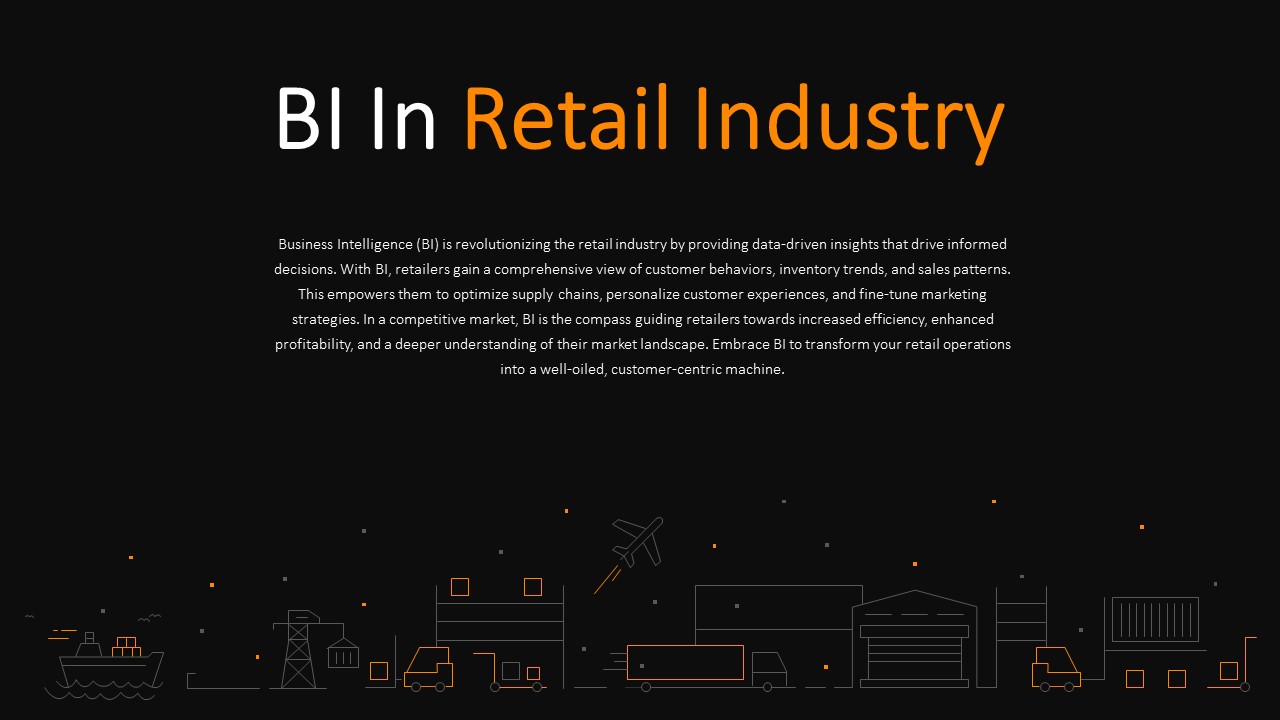Business Intelligence (BI) in Retail PowerPoint PPT Presentation
Title: Business Intelligence (BI) in Retail
1
BI In Retail Industry
Business Intelligence (BI) is revolutionizing the
retail industry by providing data-driven insights
that drive informed decisions. With BI, retailers
gain a comprehensive view of customer behaviors,
inventory trends, and sales patterns. This
empowers them to optimize supply chains,
personalize customer experiences, and fine-tune
marketing strategies. In a competitive market, BI
is the compass guiding retailers towards
increased efficiency, enhanced profitability, and
a deeper understanding of their market landscape.
Embrace BI to transform your retail operations
into a well-oiled, customer-centric machine.
2
Overview of BI in Retail Industry.
The global retail market size reached over USD 23
trillion in 2020 and is anticipated to increase
at a healthy rate between 2023 and 2028. As one
of the most data-driven businesses, retail
companies are increasingly turning to Business
Intelligence to capitalize on possibilities.
Business intelligence (BI) technologies assist
retailers in organizing, analyzing, and
contextualizing business data. And with reports,
performance metrics, and corporate trends, it
allows for informed decision making in the
present. In addition, BI enables retailers to
estimate sales, assess market potential, and get
a greater understanding of consumers.
3
Source Statista In the next few years, the
global market for business intelligence and
analytics software solutions is expected to grow
from 15.2 billion U.S. dollars in 2020 to more
than 18 billion in 2025 it goes without saying
that BI can boost the retail sector specifically.
4
Benefits of BI in Retail Business Intelligence
allows organizations to grasp large amount of
data about sales to market trends, customer
behavior needs, and more. The data analyzed
with the help of BI tools helps businesses to
connect with its customers.
5
Here are the few key benefits of business
intelligence in the retail industry In-depth
comprehension of patrons behavior Customer
satisfaction is the cornerstone to every
business's success. It offers value to the
company, aids in customer retention, minimizes
staff turnover, and enhances brand loyalty.
Business Intelligence can assist merchants in
identifying their customer, desires, and
behaviors. This data may be used to enhance
customer service and create more successful
marketing initiatives. Enhanced Inventory
Management Inventory control is the foundation
of every successful retail operation. It includes
the procurement, storage, and sale of raw
materials and completed commodities. Any retail
organization with inventory has a number of
inventory challenges. From ineffective monitoring
to overstocking challenges, inventory management
can be challenging for merchants. BI and data
analytics solution, however, can aid in inventory
management and eliminate the majority of
stock-related issues shops experience.
6
Store Floor Plan Optimization One of the
primary reasons retailers use BI is to create a
floor layout that would entice customers to spend
significant time shopping. Businesses should
choose a layout that enables clients to shop
without hassle. With the aid of business
intelligence tools, they may examine many data
sets such as the number of stops, the length of
each visit, and the items purchased and propose a
layout that will make it easier for customers to
locate what they're looking for. Improved
Merchandising Merchandising is the most crucial
aspect of a retailer's operation and one in which
merchants are starting to fully harness the
advantages of business intelligence. The initial
distribution of products across channels and
outlets is more precise when the analysis of
previous success is paired with plans and
estimates of future consumer behavior. Based on
client demand patterns, assortment and size
optimization ensures that the relevant
assortments, sizes, and case-pack distributions
are provided to the correct retailers. Pre-season
and in-season pricing, promotion, and markdown
optimization ensures that goods are priced for
maximum profitability.
7
Efficacious marketing With the proliferation of
social media tools and marketing platforms, the
marketing business has become more data-driven.
To get the greatest results from a marketing
plan, however, firms must have a system in place
that can give relevant insights and evaluate data
on the purchasing behavior of customers.
Consequently, BI tools come into play. They
increase the effectiveness of a company's
marketing initiatives. Core Functionality of
Retail BI solution Data Consolidation
Inventory Management Data Analysis and
Reporting Assortment
Management Data Representation
Price Optimization Customer Analytics
8
Emergence of Retail Business Intelligence
Ecosystem Due to the emergence of channels
offering similar choices and competitive pricing,
retailers must sharpen their customer-centric
strategy to maintain brand loyalty. Retailers
need to understand behavior, trends, and
competition and leverage insights at the right
time. ebizframeBI helps retailers run more
effective loyalty programs and make better
business decisions.
9
Case Study based on the effects of BI in Retail
Industries One of the biggest suppliers of
electronic appliances in West Africa. With over
15 years in the consumer electronics sector, it
is geared towards bringing the latest technology
to your doorsteps, bringing happiness into the
lives of individuals, homes, offices, and the
hospitality sector in West Africa. The company
was using the traditional ERP system till 2019.
The company implemented ebizframeBI in 2020,
which changed its business model. The business
transformation towards better performance.
Although revenue fell in Apr-20 rest of the
months, have performed much better than the
previous year. Similarly, with continuous use of
BI and having benefited from it, they further
capitalized on the tool's capabilities and
decided to completely automate management MIS.

